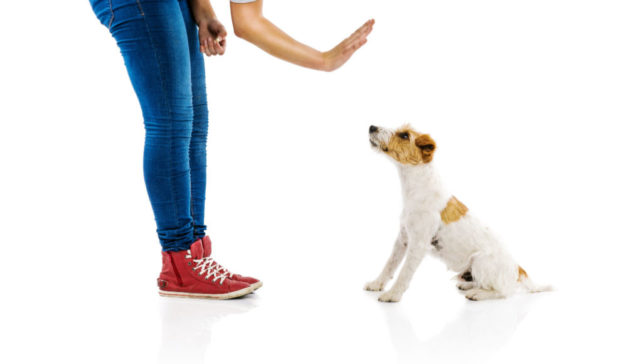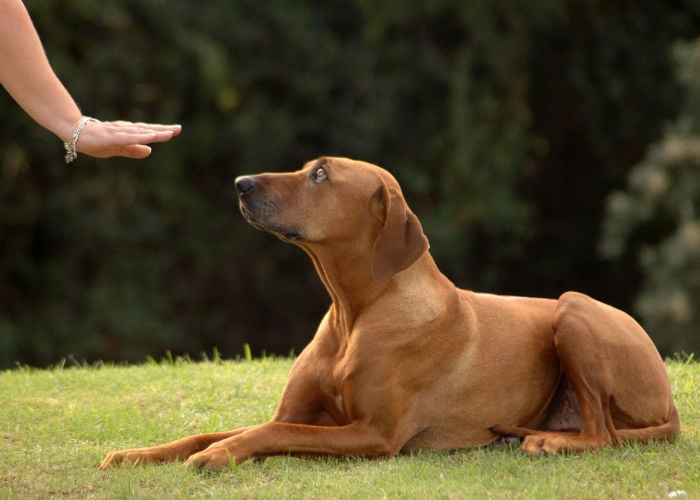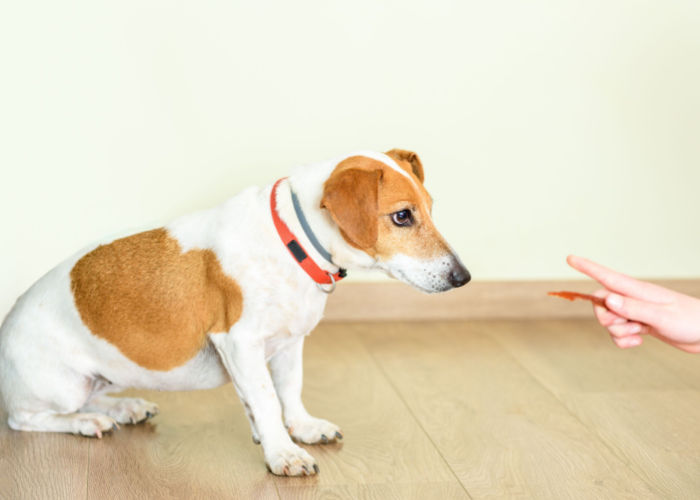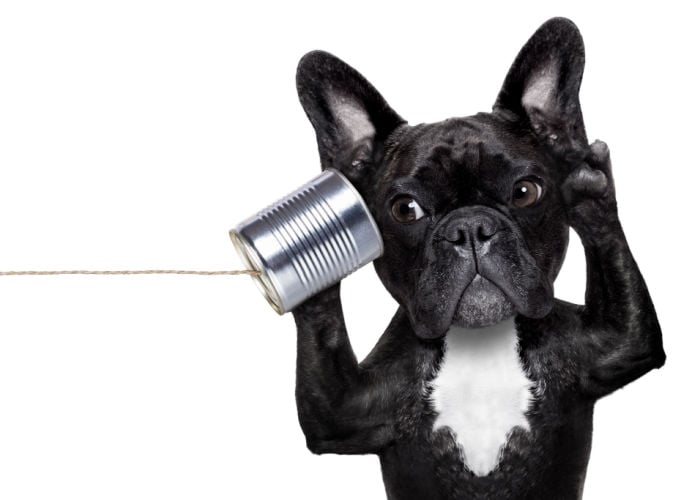
Table of Contents
You may think that deaf dog training is way harder than training a hearing dog, but in reality, they are more similar than you thought.
Although extra training aids and hand signals may be required to help deaf dogs in their training, the same goals and principles apply—you want them to get used to their surroundings and to you as their master.
While certain breeds like Australian Shepherds, Boston Terriers, and Cocker Spaniels are more prone to getting hearing disabilities, others get it due to old age.
Regardless of the reason or cause, teaching them several commands will not only help them cope with losing their auditory senses but will also help them maximize their potential to be the best dog that they can be.
Deaf Dog Training: What to Expect?
Nothing worthwhile comes without extra effort and extra patience—deaf dog owners can expect they'll need a lot of these to train their differently-abled pooch.
And trust us, it's worth going the extra mile in teaching them.
There are basically two things you need in deaf dog training: first are hand signals, and second are training aids.
Hand Signals/ Sign Language
In deaf dog training, you will need to establish hand signals or sign language your dog can easily understand.
Hand signals don't have to be based on American Sign Language or even the international standard; they only have to be easily recognizable and replicated.
You can even make up your own hand signals if that makes it easier for you and your deafie to communicate! Not only that, but you also have to make sure you can easily repeat it exactly as it is. Just make sure your signals are not too similar to one another, or else it might confuse your pooch!
We also recommend checking out this easy-to-learn and easy-to-teach handbook on deaf dog sign language for additional ideas.
Training Aids for Deaf Dogs
Although they may be hard in hearing, deaf dogs compensate for it by using their other senses, like their sight and smell.
Because of this, using training aids is extra helpful in reinforcing the hand signals you will teach them in their training.
Training Clickers
 Clickers like this are handy devices that can act as a marker for their obedience. Positive reinforcement is helpful in letting them know they did well. They may not be able to hear it, but seeing you use it can still send the signal that they did well and that they will be rewarded for it.
Clickers like this are handy devices that can act as a marker for their obedience. Positive reinforcement is helpful in letting them know they did well. They may not be able to hear it, but seeing you use it can still send the signal that they did well and that they will be rewarded for it.
Flashlights or Laser lights
 You can also consider using flashlights or laser lights like this to easily get their attention. Deaf dogs won't likely hear their names when you call them, and they'd probably get startled when you suddenly touch them, especially when they're sleeping.
You can also consider using flashlights or laser lights like this to easily get their attention. Deaf dogs won't likely hear their names when you call them, and they'd probably get startled when you suddenly touch them, especially when they're sleeping.
Flashing lights in their direction can get them to pay attention to you. Just don't flash it directly to their face and eyes, of course!
Dog Training Whistle
 Some deaf dogs can pick up the frequency caused by the high-shrill sound of dog whistles. If your pooch is lucky enough, you can use whistles like this for easier training.
Some deaf dogs can pick up the frequency caused by the high-shrill sound of dog whistles. If your pooch is lucky enough, you can use whistles like this for easier training.
Just don't forget to reward them afterward for a job well done!
Vibrating Collars
Vibrating collars are always the first to pop up when searching for training aids for deaf dogs.
Here, the owner can set the vibrations for different commands for the dog to feel.
However, you should always be wary of using this. Some deaf dogs are very sensitive; even the slightest vibrations might put them off.
Test first if they're comfortable with it. You can check out our recommendations for the best-vibrating collars available in the market.
But if you see their discomfort, it's best to consider using other training aids.
After all, we want to give them the best possible positive experience during training.
Dog Training Treats
What better motivation to convince our furry friends to learn than by giving them tasty treats?
This could easily be the most important training aid you can get your hands on!
Of course, just make sure that you're giving them not only a delicious treat but a healthy one as well.
Also, it's best to cut back on what they eat when training them with treats. You surely don't want an overweight pup, do you?
Here, we listed down the best healthy dog treats you can give your deafie as training treats.
If they can be motivated with toys, you can also use that as an alternate reward instead!
How To Train a Deaf Dog
Once you've got your training aids ready, you and your dog can get on with the training. But how to start?
Remember that positive reinforcement is the key to successfully training dogs, whether they are hearing or deaf.
Here are a couple of know-hows you can use as a guide for deaf dog training.
Teach the “Focus” or “Watch Me” Cue
The best thing to teach your deafie, for starters, is the Focus signal.
Remember that you can't easily get their attention by calling their names. They have to have visual cues before they can actually focus on you.
This is not easy, especially when there are lots of things going on in their surroundings.
That's why you have to make sure to remove all distractions before starting your training.
You can start by praising them and giving them treats every time they look at you voluntarily.
You can also start doing your chosen signal so they associate it with the action.
Here, you can turn on and off a flashlight or even stomp your feet to get their attention as they feel the vibration on the floor or the ground.
Once your deafie gets the hang of this, it'll be easier to teach them other cues.
Teach a Marker Signal
A marker is as it sounds–giving your dog a signal that he did well.
Whenever he's able to do what you're teaching him, giving the marker signal followed by treats will make him repeat it again and again until he gets used to it.
A clicker can work best as a marker signal even for deaf dogs, but simply giving your dog a thumbs up or ear scratches can work, too!
Startle Training
Because deaf dogs are easily startled, it's best to desensitize them.
Teach them to get used to your touch even when they're sleeping. Offer treats right after so they'd know it only means good things.
Dogs that are not trained for this can get snappy and aggressive, especially deafies who can't hear your approach.
They can easily get scared by any sudden movement or sensation.
The American Kennel Club also has this guide to changing a dog's behavior through desensitization.
Different Techniques in Training Deaf Dogs
Once you have the focus, the marker, and the startle training laid down, you can start teaching them whatever tricks you want.
You can use the following techniques to get them started.
Mark and Reward
As we discussed, teaching our dogs a marker signal is important to let them know they're doing a good job.
But always make sure that you follow it up with a reward. Or else, what's in it for them, right?
A marker signal and a reward should always go hand in hand to encourage them to repeatedly do whatever trick you're teaching them.
Lure and Reward
Once you get your deaf dog's attention, you sure can keep it by using treats.
Keep one in your hand, and best believe, he'll be following it with his eyes.
You can take advantage of this by “luring” him into doing a trick.
Say you want to teach him “Sit.” You can try raising your hand with the treat above his nose.
He'll surely follow it, causing him to sit down to reach it. Once he did, give him the marker signal and his reward.
After a while, try incorporating your chosen hand signal for sitting. When done repeatedly, your deafie will pick this up as his cue to sit.
Capture and Reward
Capturing is like taking a photo, but instead of clicking a camera, you reward your dog when you catch them doing the exact gesture you want to teach them.
For example, you want to train him in the cue for “Down.” Wait for a moment when your dog is about to lie down. Once he did, mark the behavior and give him a treat.
And just like in luring, incorporate your hand signal for down once your dog gets used to the cue.
Additional Tips on Deaf Dog Training
Here are some additional tips you can remember when training your deaf dog, regardless of whether his condition is an inborn trait or due to old age.
 Read books about deaf dogs. Learning from experts will definitely help you and your dog cope and live together harmoniously.
Read books about deaf dogs. Learning from experts will definitely help you and your dog cope and live together harmoniously.- Train them in a safe and fenced area. If in an unfenced, open space, make sure they are leashed to keep them safe.
- Remove or minimize any distractions in their surroundings when teaching them.
- Always have their name tags updated with your latest contact information. Also, make sure their hearing condition is indicated on the tag.
- Try to incorporate hand signals or sign language when teaching even puppies who don't have hearing problems yet. This will prepare them for later on in life, just in case.
- You can also speak out commands as if your deaf dog will hear you.
- Avoid the use of shock collars. Vibrating collars may be already too much for some dogs, more so a shock collar.
- The most important tip of all is to be patient!
FAQs on Deaf Dog Training
Can a deaf dog hear a dog whistle?
A dog's hearing condition varies on how severe the damage is.
There are some deaf dogs who can pick up the frequency of a shrill dog whistle.
However, others start losing their ability to hear high-frequency sounds first.
Your best bet is to test the extent of your dog's capability is to test it.
If he reacts to a whistle, even as much as an ear twitch, then he probably could pick it up.
But if none at all, you might want to resort to visual cues or vibrations to train him instead.
Can you leave a deaf dog home alone?
Just like any other dogs, whether abled or differently abled, deaf dogs can also get separation anxiety when left alone at home.
The good thing, though, is that they can also be trained for it.
Leaving them in increments for a couple of minutes, then hours every day, will eventually get them used to being left alone by themselves.
Also, teach them that good things can still happen when they're alone.
Leave behind treats for them to hunt, set up a ledge near the window so they can see outside, or provide a comfortable spot where they can rest while waiting for you to come home.
Can deaf dogs read lips?
Yes, our dogs are actually able to read our lips, but probably not in the way we think.
Dogs are actually smart enough to make an association with our mouth movements and the instruction being given.
This is why it's encouraged to speak out the commands when training them as if they would hear you.
They may not hear, but they surely are watching you open and close your mouth as you speak.
Deaf Dog Training — Final Thoughts
Experts say deaf dogs learn just the way other dogs do.
Sure, deaf dog training may be intimidating and a bit daunting in the beginning, especially for newbie owners.
But remember that there are a lot of resources to teach both you and your dog the proper sign language and hand signals, as well as some training advice for deaf dogs.
All it takes is effort, time, and patience to train your deafie, and you'll be assured of a worthwhile reward in the end!
















